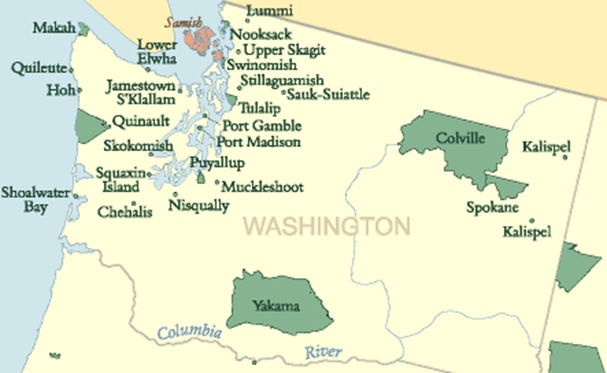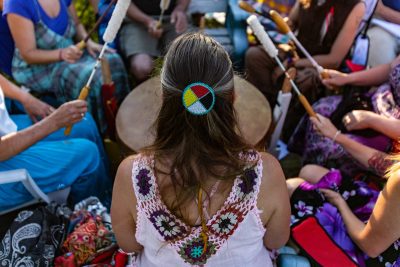Vocational Rehabilitation (VR) is a service provided to help someone with a disability get ready for work, access a job, maintain a job, and more. The right to VR services is guaranteed under federal law, the Rehabilitation Act of 1973, which grew from regulations in place since the Smith-Fess Act of 1920 established the first employment protections for people with disabilities.
The right to Tribal Vocational Rehabilitation (TVR) is newer and offers an option for some people who are members of a federally or state-recognized Native American Tribe.
Washington State’s Department of Services for the Blind (DSB), which offers VR to individuals who are blind or visually impaired, maintains a website page to help people find and contact Tribal Vocational Rehabilitation Organizations in many regions of Washington State.
Washington’s Division of Vocational Rehabilitation (DVR) also maintains a website page to help clients find information about Tribal Vocational Rehabilitation Programs.
TVR provides culturally supportive services
Tribal VR can provide services that are culturally supportive. Federal law (34 CFR, Subsection 371.41) allows AIVRS projects to include “expenditures for services reflecting the cultural background of the American Indians being served, including treatment provided by native healing practitioners who are recognized as such by the tribal vocational rehabilitation program when the services are necessary to assist an individual with disabilities to achieve his or her vocational rehabilitation objective.”
Christopher Zilar, who directs the Spokane Tribe Vocational Rehabilitation Program, provided information for this article. He shares an experience to help spread understanding about what cultural awareness can look like:
“In one case, a client felt the need for healing for his addiction to alcohol. His TVR counselor was able to set him up with a locally known spiritual healer. The counselor was able to provide smudge. Lastly, when the client asked the counselor to pray with him, the counselor was able to do so. This was a perfectly acceptable approach to helping the client stay on track with his employment goal, and yet not something one would experience in a traditional DVR setting.”
Washington is a leader in providing TVR Tribal Vocational Rehabilitation was not built into federal disability protections until 1992, when a section of the Rehabilitation Act was amended to establish American Indian Vocational Rehabilitation Services (AIVRS), which serves 91 programs in 25 states. The states with the most AIVRS programs are Alaska (12), Washington State (11), and Oklahoma (10). For a United States map and further information, visit aivrttac.org.
Below is a map that shows many of the tribes in Washington State. Of 574 federally recognized tribes, 29 are in WA State. Many of the state’s larger tribes have their own VR programs, and some smaller tribes belong to a cooperative of tribes that serve a sizeable area. Many AIVRS projects will serve members of any federally or state-recognized tribe.

Historical Note: The long process that resulted in the establishment of AIVRS began in 1972, when Navajo Nation requested funds and authority from Arizona State Department of Labor to provide VR services to their tribal members.
As part of federal disability rights and protections, AIVRS programs now function much like state-run VR programs. Eligible participants build a plan for employment, and VR services are individualized to meet the person’s interests, strengths, and goals.
Here are a few unique aspects of AIVRS:
- State-run programs, such as Washington’s DVR, are guaranteed funding and federal dollars fluctuate based on the state’s population. AIVRS projects must apply for five-year federal grants, and dollars are awarded for the grant period based on the application. An AIVRS project must re-apply every five years and is not guaranteed a grant.
- Unlike programs that are contained within state borders, AIVRS projects may define their own service areas that consider reservation boundaries and/or ancestral lands. Service areas may overlap and clients living in areas where programs overlap may be served by overlapping programs.
- AIVRS projects only serve American Indians who are members of a federal or state recognized tribe.
TVR is unlikely to put you on a wait list
Order of Selection refers to a waiting list that goes into effect when there aren’t enough VR resources to meet the need. Washington’s DVR often operates with an Order of Selection process, which organizes applicants based on the severity of their disability condition and when they applied.
Order of Selection is extremely rare among AIVRS projects, with no AIVRS projects in Washington State operating with a waiting list in Summer 2022. Tribal clients waiting for services from state agencies can request help from AIVRS, and professionals working for the state also can refer tribal clients to AIVRS.
Cultural awareness is key
The impetus for Navajo Nation to begin their own project 50 years ago remains the same for many today. AIVRS project counselors often live and/or work on the reservation. They understand the public transportation challenges their clients face. They know the local entertainment, shopping, social service, and employment opportunities that are available to their clients. Most importantly, they have a better idea of what cultural needs their clients might have.
For example, one TVR specialist recalls an appointment he supported for a Native client when an uninformed VR counselor attempted to show respect by discussing the local Pow Wow and said, “I really love the costumes you wear during the dances.”
The AIVRS counselor was able to correct the error and support the Native client by clarifying that Native Americans dance attire is not a costume: “What they wear is sacred, admired, maybe passed down through many generations. We call them regalia.”
To learn more about Tribal rights under the Rehabilitation Act of 1973, as amended, search for “Tribal” throughout a downloadable transcript of the law.

